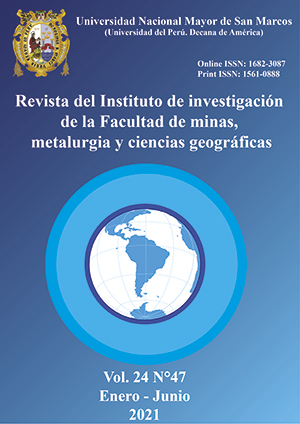Correlation of the oxide reduction potential and the bacterial population during the study copper sulphide bioleaching
DOI:
https://doi.org/10.15381/iigeo.v24i47.20639Keywords:
Oxidation-reduction potential, bacterial population, bioleaching, copper sulfides, Acidithiobacillus adaptationAbstract
The correlactionship of bacterial population and oxidation-reduction potential in the bioleaching of sulfuric minerals by bacterial strain of Aciditiobacilus Ferrooxidans isolated from acid mine effluent was studied. The solubilization of copper and gold release from a mineral with sulphides exceeding 80% was evaluated. The experimental variables were: Pulp density at 1, 2 and 6% (W/V), concentration of ferrous sulfate as part of the 9k medium of 0, 3, 6, 9 and 15 gr/L.; maintaining constant temperature and pH. The tests were carried out in three consecutive stages, starting with inoculum containing 7.05x107 Cell/mL and then the one obtained in each previous stage, observing the variation in the periods of adaptation and growth. In the first stage the maximum bacterial density reached in 24 days was 4.75x107 Cell/mL with 6 g/L of ferrous sulfate. In the second stage a maximum density of 6.30x107 Cell/mL was obtained without the addition of ferrous sulfate. In the third stage the bacterial density reached 4.51x107 Cell/mL, with exponential growth starts at approximately 13, 8 and 3 days, respectively. Bacterial strains are successfully adapted in different media containing varying amounts of iron and sulfuric minerals, regardless of iron sulfate as part of the bacterial substrat.
Downloads
Published
Issue
Section
License
Copyright (c) 2021 Vladimir Alejandro Arias Arce, Daniel Florencio Lovera Dávila, Abad Flores Paucarima, Tito Libio Sánchez Rojas

This work is licensed under a Creative Commons Attribution 4.0 International License.
AUTHORS RETAIN THEIR RIGHTS:
a. Authors retain their trade mark rights and patent, and also on any process or procedure described in the article.
b. Authors retain their right to share, copy, distribute, perform and publicly communicate their article (eg, to place their article in an institutional repository or publish it in a book), with an acknowledgment of its initial publication in the Rev. Inst. investig. Fac. minas metal cienc. geogr.
c. Authors retain theirs right to make a subsequent publication of their work, to use the article or any part thereof (eg a compilation of his papers, lecture notes, thesis, or a book), always indicating the source of publication (the originator of the work, journal, volume, number and date).






